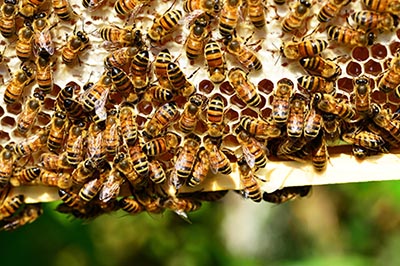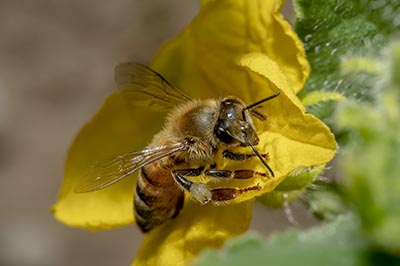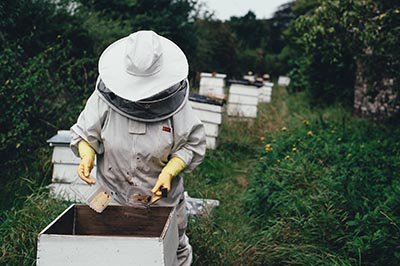Q: Is swarming natural?
A: Yes, it is a completely natural process that typically happens in early spring when the population of the hive has outgrown their current nest. When bees swarm, it is a good sign that the colony is very healthy. Their queen and more than 60% of her worker bees will fill up their bodies with honey and leave the nest to find a suitable location to build a new one. The other 40% of the worker bees will remain at the old nest to raise a new queen.
Q: Are bees dangerous when swarming?
A: Short answer: No, they are actually very calm because they are not defending honey, pollen and brood.
During a swarm, the honey bees will have gorged themselves with honey from their previous nest so they are pretty docile. With their bodies full of honey, they cannot move their bodies into a good position to sting. It is also important to remember that the queen is naturally large and cannot fly very far so the bees will defend her by clustering around her as they wait for another suitable location for a new nest.
Q: When will a swarm establish a new nest?
A: When a bee hive swarms and cluster up on the branches of trees/bushes, they will send out 20-50 scout bees to find a suitable nest site. These scout bees are extremely efficient at their jobs and can find a new nest site in less than 24 hours whether it be in tree trunk, bee box or hollow wall near the old nest site. It is unusual for a swarm to cluster up for more than 3 days.
Q: How do the worker bees at the old nest site gain another queen?
A: They raise a new one. Throughout the entire year, the worker bees will create queen cups. When a hive is ready to swarm, the queen will lay eggs into these queen cups. The laying queen will swarm before the new queen hatches.
Q: How does the hive prepare for a swarm?
A: The queen is naturally too heavy to fly long distances so the worker bees will stop feeding the queen royal jelly days before the anticipated swarm date.
Q: What happens to the old hive after the old queen and half the hive swarms?
A: The worker bees will raise a new queen. Throughout the entire year, the worker bees will create queen cups. When a hive is ready to swarm, the queen will lay eggs into these queen cups. The laying queen will swarm before these new queen’s hatch. Once the virgin queen emerges from her cell, she will fly outside the hive for the first and only time to mate in flight.
Q: Are there any risks for the honey bees during a swarm?
A: Yes, since they have a limited honey store during this period, it is crucial that they find a new nest site as soon as possible. Sunny days on the day of the storm followed by rain is a common risk that casts away swarms face when finding a suitable nest location in the spring/early summer. Since the scout bees use the sun to navigate and communicate to the other worker bees, a cloudy rainy day will put the swarm at the risk of starvation. At the old site, the new virgin queen will face predators as she makes her brief flight outside the hive to mate.


